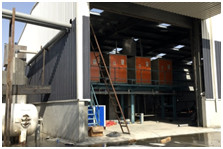Kaolin Purification Process in Malaysia
The main components of kaolin are kaolinite and coal-bearing kaolinite. It is more matte, and it is delicate and white when pure, such as gray, yellow, brown, etc. when it contains impurities. Is a non-metallic mineral, is a clay and clay rock dominated by kaolinite clay minerals. Because it is white and delicate, it is also called dolomite. It is named after Gaoling Village, Jingde Town, Jiangxi Province. China's high territories are mainly distributed in Jiangxi, Fujian, Hunan, Anhui, Suzhou, etc. Inner Mongolia is mainly coal mine high collar stones. Pure kaolin is white, delicate, and soft, and has good plasticity and fire resistance. Its mineral composition is mainly composed of kaolinite, halloysite, hydromica, illite, montmorillonite and quartz, feldspar and other minerals. Kaolin is widely used, mainly for papermaking, ceramics and refractory materials, followed by coatings, rubber fillers, ceramic glazes and white cement raw materials, and a small amount is used in plastics, paints, pigments, abrasive wheels, pencils, daily cosmetics, soap, Pesticide, medicine, textile, petroleum, chemical, building materials, battery materials, national defense and other industrial sectors. The application of raw ore to the market must be purified and whitened. Whiteness is one of the main parameters of kaolin process performance. Kaolin with high purity is white. Kaolin whiteness is divided into natural whiteness and whiteness after calcination. For ceramic raw materials, the whiteness after calcination is more important. The higher the calcined whiteness, the better the quality. Ceramic technology requires that drying at 105 ° C is the classification standard for natural whiteness, and calcination at 1300 ° C is the classification standard for calcined whiteness. The color of kaolin is mainly related to the metal oxides or organic matter it contains. In general, Fe2O3 contains rose red and brown yellow; Fe2 + contains light blue and light green; MnO2 contains light brown; organic matter contains light yellow, gray, blue, and black. The entire purification process flow from raw ore to flushing feed beating machine, spiral fine sander will be finely sorted through fine sand and roller sieve twice, and then enter the slurry pool for pulping, cyclone 2 times grade to the transfer tank , Enter the electromagnetic slurry iron remover for fine iron removal, then enter the concentration tank and finally go to the frame filter press to the finished product. According to the different requirements of each customer, the iron removal part can also be divided into 1 time iron removal and 2 times iron removal.
|







